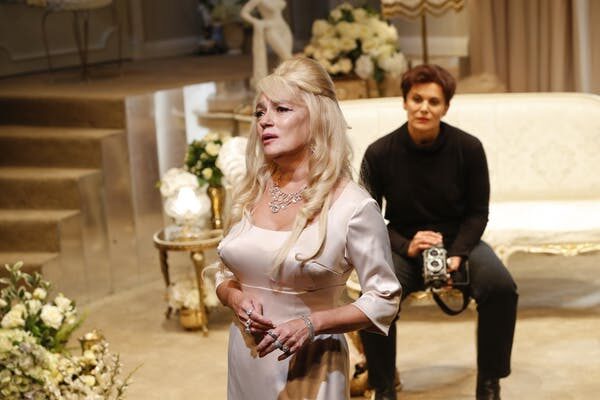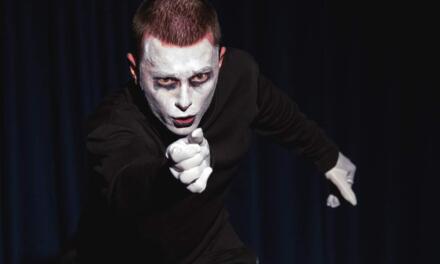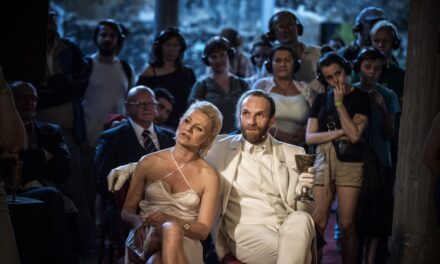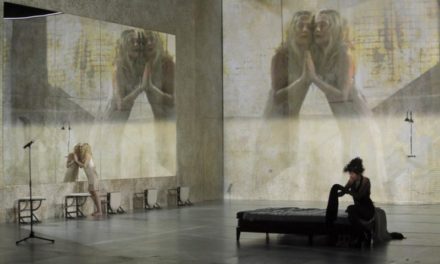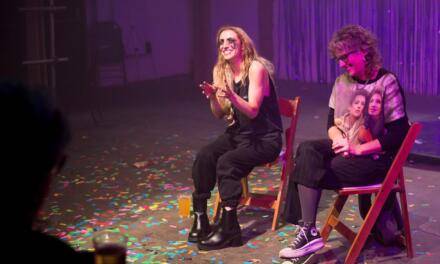In the world premiere production of Arbus and West, Playwright Stephen Sewell appears to be straying into uncharted territory. He is renowned for being a hard-hitting political writer, whose epic plays are almost always described as “dark”.
Here, Sewell reimagines the real-life encounter between Hollywood icon Mae West and avant-garde photographer Diane Arbus. Key moments in the lives of these two fascinating 20th-century artists provide the seductive scaffolding for the play.
It is far from documentary-like, however. The dialogue is charming and comedic, while the theme of women’s eviscerated position in society slowly boils over and erupts to the surface.
The biographies of both Arbus and West are compelling fare. West is lauded as a trailblazing Hollywood performer, an activist, and emblem of female sexual agency. Arbus is known for redefining the photographic gaze, focusing on human subjects who were considered pariahs and shinned by American society during the 1960s. In 1971, Arbus committed suicide.
West felt Arbus’s portrait of her was unflattering and in Sewell’s play never forgives her for it. But the play doesn’t rest entirely on fact. The women are at once real historical figures but also emblems of different artistic genres, political sensibilities, and strands of feminism.
Arbus and West’s encounter is a mere snapshot in time, taking place over the course of the afternoon. The production transforms this small moment into a sweeping panorama, as though the event of their meeting transcended historical time altogether, delivering a dreamy interpretation of the human condition, and the position of women within it.
The drama takes place in West’s apartment, a monument to camp style, with its chandelier, white upholstered furniture and multi-storeyed window bathing the space in an almost transcendental light.
Many scenes unfold as duologues between Arbus (Diana Glenn) and West (Melita Jurisic), but also between West and her live-in dresser and devoted assistant Ruby (Jennifer Vuletic).
The play begins with Ruby eagerly preparing to assist West with her costume changes during a stage performance. We hear but do not see West signing before an adoring audience- a master of ceremony refers to the size of her breasts as the fictional crowd roars.
A sense of creeping nostalgia sweeps over the stage, enhanced by the effect of West’s voice traveling across distant space and time. West retreats backstage when Ruby reluctantly delivers the news of Arbus’s suicide. She shrugs it off but is clearly affected.
The Female Gaze
The play then jumps back in time to where West is preparing for an interview and photoshoot with an unknown photographer. When the photographer named Arbus arrives, we discover she’s a woman. West doesn’t know how to be the object of a woman’s gaze. It is foreign, disconcerting, far too intimate and penetrating.
Quippy one-liners dominate the first act: “If you’re a photographer”, West says to Arbus, “I’m a monkey’s gynecologist.”
Discussion about what is real and what is fantasy abound. Arbus seduces West with her poetic interpretation of life but repels her in equal measure. West and Ruby agree to unravel the mystery of Arbus: what does she want, why does she insist on capturing the truth, the ugly side of humanity?
By the end of the first act, we see West in a state of rapture. She’s convinced that Arbus is an emissary come back from the dead to deliver her a message: that she’s been living a half-life from which she needs to “wake up”.
West unravels the message while spontaneously sharing an earth-shattering confession with Ruby, recalling the gruesome beheading of a childhood friend. The murderer was the girl’s father- his motive can only be described as Freudian. West has a dawning realization: Arbus is a manifestation of the murdered girl.
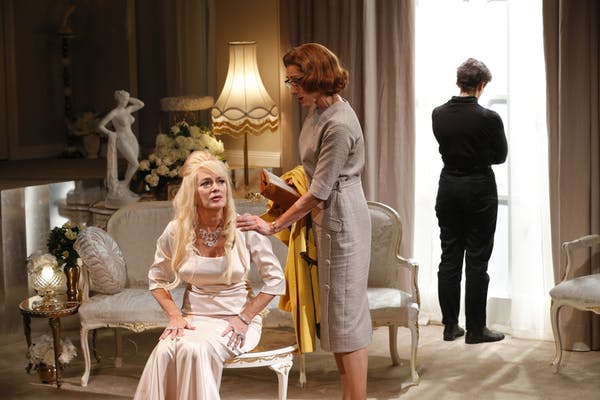
The play is a series of duologues between Arbus and West, and between West and her assistant Ruby. Photo by Jeff Busby.
Jurisic as West is captivating in this moment, as she grapples with the truth and horror of the suppressed memory. Sarah Goodes’ directorial hand is subtle but shifts the mood convincingly with West delivering the details of the murder as a direct address to the audience.
Part of the pleasure in Sewell’s writing for this play is that the genre escapes us. Not a straight theatrical biopic, it verges on a supernatural crime thriller, a feeling greatly enhanced by the elements of the production and the actors’ commanding performances.
But we already know who the dead person is (Arbus) and the circumstances surrounding her death: suicide. Here Sewell delivers a different kind of crime thriller that transcends the particulars of these characters’ lives. The silent villain is an enduring misogyny that sweeps across historical time like a nuclear explosion.
Towards the end of the play, Arbus whispers a secret into West’s ear. It is a galvanizing moment, where the pair become conspirators. After much suspicion and argument, West finally acquiesces to Arbus’s desire to photograph her candidly.
It is as though the playwright is whispering to us. I can’t be sure of the message, but I suspect that Sewell has found a different way to be political with this play. He empathizes with West’s realization that being a woman is tantamount to living in a dream state, trapped in a condition of artifice and alienation from the world.
It is to enter a contractual agreement to live as though you were a species of living dead trapped beneath a crust of glamour. A narcotic existence, so seemingly pleasurable and sensual that the terror of it escapes all our notice.
I may be overreaching here, but in the era of #MeToo in the Australian theatrical context, there is something deeply hopeful about our most prominent playwrights developing a feminist politics in their work.
This article was originally posted at theconversation.com on March 6th, 2019 and has been reposted with permission. To read the original article, click here.
This post was written by the author in their personal capacity.The opinions expressed in this article are the author’s own and do not reflect the view of The Theatre Times, their staff or collaborators.
This post was written by Sandra D'urso.
The views expressed here belong to the author and do not necessarily reflect our views and opinions.

